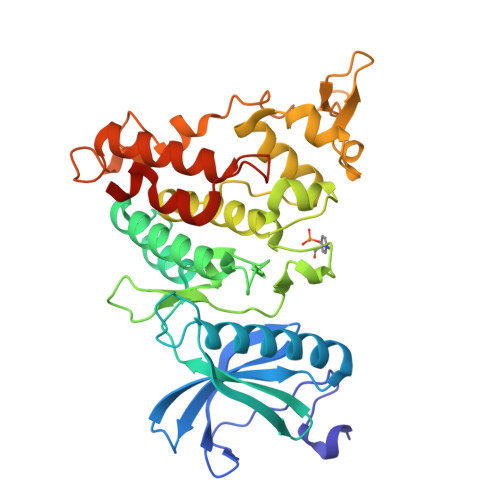Identification, biological evaluation, and crystallographic analysis of coumestrol as a novel dual-specificity tyrosine-phosphorylation-regulated kinase 1A inhibitor.
Peng, C.H., Hwang, T.L., Hung, S.C., Tu, H.J., Tseng, Y.T., Lin, T.E., Lee, C.C., Tseng, Y.C., Ko, C.Y., Yen, S.C., Hsu, K.C., Pan, S.L., HuangFu, W.C.(2024) Int J Biol Macromol 282: 136860-136860
- PubMed: 39481728
- DOI: https://doi.org/10.1016/j.ijbiomac.2024.136860
- Primary Citation of Related Structures:
8YEV - PubMed Abstract:
Alzheimer's disease (AD) is an irreversible neurodegenerative disease, with tau pathology caused by abnormally activated dual-specificity tyrosine-phosphorylation-regulated kinase 1A (DYRK1A) being one of the culprits. Coumestrol, a phytoestrogen and natural antioxidant found in various plants, has been reported to alleviate AD, but the underlying mechanism remains unclear. We confirmed coumestrol as a novel DYRK1A inhibitor through enzyme-based assays, X-ray crystallography, and cell line experiments. Coumestrol exhibited minimal cytotoxicity at concentrations up to 100 μM in cell types such as N2A and SH-SY5Y and reduced DYRK1A-induced phosphorylated tau protein levels by >50 % at 60 μM. In the tau protein phosphorylation and microtubule assembly assay, coumestrol at 30 μM reduced phosphorylated tau by >50 % and restored the microtubule assembly process. Coumestrol also significantly reduced amyloid-β (Aβ)-induced oxidative stress in microglia at 1 μM. In zebrafish larvae co-overexpressing DYRK1A and tau, coumestrol mitigated neuronal damage and protected motor function at 48 h-postfertilization. Our results suggest that coumestrol has potential therapeutic effects in AD by inhibiting DYRK1A, lowering p-Tau levels, restoring microtubule assembly, and protecting microglia cells from Aβ-induced cell death, providing new insights into the development of coumestrol as a potential AD treatment.
- Ph.D. Program for Cancer Molecular Biology and Drug Discovery, College of Medical Science and Technology, Taipei Medical University and Academia Sinica, Taipei, Taiwan.
Organizational Affiliation:


















